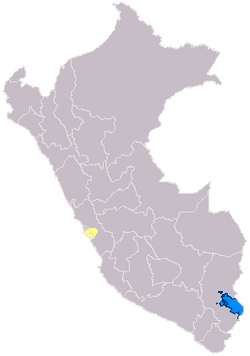This article needs to be updated. (January 2023) |
Ichma Kingdom Ichma | |||||||||
|---|---|---|---|---|---|---|---|---|---|
| 1100–1469 | |||||||||
 Domain of the Ichma or Ychsma people (in yellow) | |||||||||
| Location | Lima | ||||||||
| Capital | Pachacamac | ||||||||
| Government | Diarchy | ||||||||
| History | |||||||||
• Established | 1100 | ||||||||
• Disestablished | 1469 | ||||||||
| |||||||||
The Ichma kingdom (also written Ychma or Yschma, among other spellings) or Pachacamac kingdom[1][2] was a pre-Inca indigenous polity later absorbed by the Inca Empire and reorganized as a wanami (province). For the Inca it was known as Pachakamaq (Pachacamac), rather than its original name of Ishma.
The Ishmay Kingdom was located south of Lima, Peru in the Lurín River valley; it later spread north into the Rímac River's valley. The Ishma culture was formed around 1100 AD following the breakup of the Wari Empire. Ishma autonomy lasted until around 1469 when they were absorbed into the Incan Empire.[3]
Despite occupying a desert, the inhabitants of Ishma had a high standard of living, thanks to their expertise in devising multiple irrigation channels as far as the river waters could reach, to give life to an extensive orchard and forest.[4]
- ^ Mora, César Gálvez; Rochietti, Ana (2018-03-20). Patrimonio cultural del Perú: Humanidad andina (in Spanish). Eduvim. ISBN 9789876992206.
- ^ (Rostworowski, 1989: 71, 1992: 77)
- ^ "Lima History, the Chancay and Ichma Culture". www.limaeasy.com. Archived from the original on 2012-07-31. Retrieved 2012-05-25.
- ^ Soriano, Valdemar Espinoza (2014). "La etnia Ishma (Ychsma, Ichma, Ichmay)" [The ethnic Ishma (Ychsma, Ichma, Ichmay)]. Investigaciones Sociales (in Spanish). 18 (32): 117–159. doi:10.15381/is.v18i32.10950. ISSN 1818-4758.